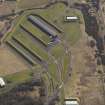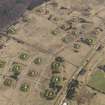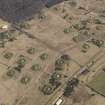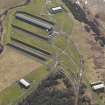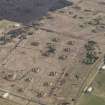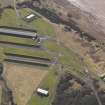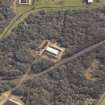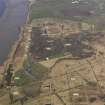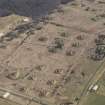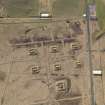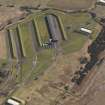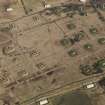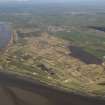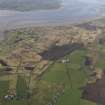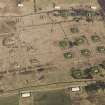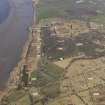Gretna, Hm Factory, Eastriggs Explosives Factory, Site 3
Explosives Factory (First World War), Military Depot (20th Century), Military Depot (Second World War)
Site Name Gretna, Hm Factory, Eastriggs Explosives Factory, Site 3
Classification Explosives Factory (First World War), Military Depot (20th Century), Military Depot (Second World War)
Canmore ID 121308
Site Number NY26SE 10
NGR NY 2638 6447
NGR Description Centred NY 2638 6447
Datum OSGB36 - NGR
Permalink http://canmore.org.uk/site/121308
- Council Dumfries And Galloway
- Parish Gretna
- Former Region Dumfries And Galloway
- Former District Annandale And Eskdale
- Former County Dumfries-shire
NY26SE 10 centred 2638 6447
NY26SE 10.01 NY 2507 6466 Pillbox
NY26SE 10.02 centred NY 2486 6545 Gatehouse and main gates
See also NY26NW 46
Part of the Eastriggs Explosives factory.
The explosives works and stores are visible on a series of RAF WW II oblique aerial photographs (F 309, 10572-10591, flown 26 January 1942), which show the general layout of the works. The works are also visible on more recent vertical air photographs (All Scotland Survey [Jasair], 507 88 140-142, flown 10 June 1988), which show that much of the site had been abandoned by that date.
Information from RCAHMS (DE), April 2006
WWI and WWII explosives stores situated SW of Eastirggs. The site is still used by the Ministry of Defence, access is still restricted. The site forms part of a larger area for which see NY26SE 10.
J Guy 1999; NMRS MS 810/6, 102-103 (vol.1)
The explosives works and stores are visible on a series of RAF WW II oblique aerial photographs (F 309, 10572-10591, flown 26 January 1942), which show the general layout of the works. The works are also visible on more recent vertical air photographs (All Scotland Survey [Jasair], 507 88 140-142, flown 10 June 1988), which show that much of the site had been abandoned by that date.
Information from RCAHMS (DE), April 2006
The site is now mainly used for explosives storage. Many of the huts and buildings with enclosing earth banks survive and the site retains a railway connection from the main line from Dumfries to Kilmarnock to Glasgow.
Information from RCAHMS (DE), April 2010
For specific areas see:
NY26SE 16 Nitroglycerine Hills 1-5 Area
NY26NW 91 Stores and Workshops
NY26SE 17 Nitroglycerine Refrigeration House Air Compressor and Boiler House
NY26NE 140 Nitrocotton Production area: Nitrocotton Screening House, Magazines
NY26NE 139 Boiler House
NY26SW 38 Acids Section
NY26NW 92 Glycerine Distillery and its Store Yards
NY26NW 46 Infrastructure
NY26NE 146 Drying Houses
The outbreak of the First World War found Britain relatively unprepared for the conflict, but the Government appointed Lord Moulton as Director of Explosives Production in the War Office. One of the first things he did was to arrange for a cable to be sent to South Africa to seek the service of Kenneth B. Quinan, the nephew of the renowned explosives manufacturer, W.R. Quinan, formerly of Pinole, California, USA. He had taken over the management of the factory at Somerset West, Cape Colony (South Africa), where high explosives were manufactured for DeBeers Consolidated Mines.
Having accepted Moulton’s invitation to come to Britain, Quinan set about designing the first National Factories producing armaments of which there were to be 13 overall. Unfortunately, ‘acetone’, which was one of the ingredients used in Pre-War explosives, was not available in the vast quantities required for the manufacture of cordite. However, the research department at Woolwich developed ether-alcohol as a substitute, thus creating a new type - ‘Cordite RDB’, a propellant that could be used in artillery shells. The Shell Crisis of 1915 which saw a shortage of artillery shells on the front lines added a special urgency, as the supply system for delivering munitions to the battlefields of the Western Front was under great strain. By far the largest National Factory was ‘His Majesty’s Factory, Gretna’, which like the others was under the control of the Ministry of Munitions of War. Gretna manufactured more cordite than had been produced in any of the privately owned pre-War factories put together and made a significant contribution to the outcome of the conflict. Indeed, Lloyd George declared in the House of Commons that it ‘would be hard to point to anyone who did more to win the war that Kenneth Bingham Quinan’.
Quinan was responsible for the layout and detailed planning of the Gretna factory, while the main contractors were S. Pearson and Sons Ltd under the direction of Edward Pearson. Eastriggs (Dornock) was designated as Site 3 within this National Factory, the others being Site 1 - Smalmstown, Site 2 - Mossband, and Site 4 - Gretna. Overall, at its fullest extent, the works that comprised the National Factory stretched 16 km (9 miles) from Dornock, Dumfriesshire, in the west to Longtown, Cumbria, in the east. The Eastriggs section occupied an area that extended 4km (2.5 miles) from east to west by 2km (1 mile) from north to south. It was built on 485 hectares (1,200 acres) of requisitioned farmland and marsh on the north side of the Solway Firth. This site was chosen because it had excellent communications via the Glasgow and South Western Railway and lay in a relatively unpopulated part of the country secure from possible enemy action. In addition, there was a sufficient supply of water obtainable from the River Esk, while the land was also well suited to large scale construction. Building work began in the Summer of 1915, undertaken by many thousands of labourers, most of whom came from Ireland. Temporary hostels were provided for them on site, while the dormitory town of Eastriggs to the north was built for those who were to work in the production process.
The production of RDB Cordite was complex and most of the major chemical works were conducted in the western part of the site. However, the more easterly area within Site 3 was dedicated to the to the manufacture of nitroglycerine. The cordite paste itself was produced from sulphuric acids (including oleum), nitric acid, nitrocotton and nitroglycerine, which required a wide range of raw materials, all of which had to be imported. These included sulphur, pyrites, raw glycerine, cotton rag and other ingredients, while metal and ceramic pipework, timber, bricks, coking coal, steel, cement, corrugated iron sheets etc., were necessary for the construction of the plant. The railway delivered all these materials either to the workshops or storehouses.
The Eastriggs part of the National Factory (Site 3) was divided into nine sections: the Workshop area, the Glycerine Distillery, the Acids Section, the Boiler House, the Nitrocotton production area, the Nitrocotton Drying area, the Dornock Air Compressor plant, the Nitroglycerine Hills and the Nitroglycerine Air Compressor and Boiler plant. These sections were connected by roads and trackways, while a narrow-gauge railway system ran between the Nitrocotton Drying area and the Nitroglycerine Hills. In addition, infrastructure including power transmission lines, lighting lines, telephone lines, a network of waterpipes for cooling and heating, and sewers were provided, while acids and other key chemicals were carried on overhead trestles throughout the site.
By the late Summer of 1916 the factory was already producing cordite, which was then packed into shells and consigned to the army in France. By 1917, more than 40,000 tons of cordite was being produced annually, although full production was only achieved in early 1918. After the end of the War, the Government hoped to sell the factory as a going concern, but this was not successful and by 1924 both the machinery and the buildings had been sold leading to the dismantling of much of the site.
In 1938-9, the War Office had to quickly buy back Site 3 to use as a storage depot for ammunition and bulk explosives. A new security fence was constructed, and it was renamed Eastriggs Ordnance Explosive Storage Depot. This comprised 76 storage buildings and 34 Nissen Huts - all served by a narrow-gauge railway. The latter was overseen by an Observation Post constructed from the remains of one of the five Brine Tank Towers that had been erected during the First World War in the Nitroglycerine Hills.
The depot was maintained after the end of the Second World War and its infrastructure was regularly upgraded. In the early 1980s, the standard-gauge railway line was reintroduced to bring the munitions directly into the site. Up to this point, the railhead had terminated outside the security fence to the west of the factory gates. Thereafter, the buildings and the infrastructure of the newly named Eastriggs Explosives Supply Division continued to be maintained to a high standard. This included the construction of a modern gateway and gatehouse, which were introduced in the late 1990s on the north side of the site roughly midway along the security fence.
In 2009, all ammunition was removed from Eastriggs by the Ministry of Defence because the depot was recognised as surplus to requirements. Since then, the site has been gradually decommissioned.
Information from HES Heritage Recording (MMD and ATW), 6 June 2023.
NY26SE 10
Gretna, Eastriggs Factory, site 3
During World War 1, this site produced nitrocellulose, or nitrocotton, and nitroglycerine which were used to produce Cordite, a propellant. The site was in use as a munitions depot on the date of visit.
Information from case file gathered while making preliminary site visit, RCAHMS (MKO), 30 January 1996. See Dolan and Oglethorpe, 1996 for general introduction of explosives production.
EASTRIGGS - General history of factory and depot site
The outbreak of the First World War found Britain relatively unprepared for the conflict, but the Government appointed Lord Moulton as Director of Explosives Production in the War Office. One of the first things he did was to arrange for a cable to be sent to South Africa to seek the service of Kenneth B. Quinan, the nephew of the renowned explosives manufacturer, W.R. Quinan, formerly of Pinole, California, USA. He had taken over the management of the factory at Somerset West, Cape Colony (South Africa), where high explosives were manufactured for DeBeers Consolidated Mines.
Having accepted Moulton’s invitation to come to Britain, Quinan set about designing the first National Factories producing armaments of which there were to be 13 overall. Unfortunately, ‘acetone’, which was one of the ingredients used in Pre-War explosives, was not available in the vast quantities required for the manufacture of cordite. However, the research department at Woolwich developed ether-alcohol as a substitute, thus creating a new type - ‘Cordite RDB’, a propellant that could be used in artillery shells. The Shell Crisis of 1915 which saw a shortage of artillery shells on the front lines added a special urgency, as the supply system for delivering munitions to the battlefields of the Western Front was under great strain. By far the largest National Factory was ‘His Majesty’s Factory, Gretna’, which like the others was under the control of the Ministry of Munitions of War. Gretna manufactured more cordite than had been produced in any of the privately owned pre-War factories put together and made a significant contribution to the outcome of the conflict. Indeed, Lloyd George declared in the House of Commons that it ‘would be hard to point to anyone who did more to win the war that Kenneth Bingham Quinan’.
Quinan was responsible for the layout and detailed planning of the Gretna factory, while the main contractors were S. Pearson and Sons Ltd under the direction of Edward Pearson. Eastriggs (Dornock) was designated as Site 3 within this National Factory, the others being Site 1 - Smalmstown, Site 2 - Mossband, and Site 4 - Gretna. Overall, at its fullest extent, the works that comprised the National Factory stretched 16 km (9 miles) from Dornock, Dumfriesshire, in the west to Longtown, Cumbria, in the east. The Eastriggs section occupied an area that extended 4km (2.5 miles) from east to west by 2km (1 mile) from north to south. It was built on 485 hectares (1,200 acres) of requisitioned farmland and marsh on the north side of the Solway Firth. This site was chosen because it had excellent communications via the Glasgow and South Western Railway and lay in a relatively unpopulated part of the country secure from possible enemy action. In addition, there was a sufficient supply of water obtainable from the River Esk, while the land was also well suited to large scale construction. Building work began in the Summer of 1915, undertaken by many thousands of labourers, most of whom came from Ireland. Temporary hostels were provided for them on site, while the dormitory town of Eastriggs to the north was built for those who were to work in the production process.
The production of RDB Cordite was complex and most of the major chemical works were conducted in the western part of the site. However, the more easterly area within Site 3 was dedicated to the to the manufacture of nitroglycerine. The cordite paste itself was produced from sulphuric acids (including oleum), nitric acid, nitrocotton and nitroglycerine, which required a wide range of raw materials, all of which had to be imported. These included sulphur, pyrites, raw glycerine, cotton rag and other ingredients, while metal and ceramic pipework, timber, bricks, coking coal, steel, cement, corrugated iron sheets etc., were necessary for the construction of the plant. The railway delivered all these materials either to the workshops or storehouses.
The Eastriggs part of the National Factory (Site 3) was divided into nine sections: the Workshop area, the Glycerine Distillery, the Acids Section, the Boiler House, the Nitrocotton production area, the Nitrocotton Drying area, the Dornock Air Compressor plant, the Nitroglycerine Hills and the Nitroglycerine Air Compressor and Boiler plant. These sections were connected by roads and trackways, while a narrow-gauge railway system ran between the Nitrocotton Drying area and the Nitroglycerine Hills. In addition, infrastructure including power transmission lines, lighting lines, telephone lines, a network of waterpipes for cooling and heating, and sewers were provided, while acids and other key chemicals were carried on overhead trestles throughout the site.
By the late Summer of 1916 the factory was already producing cordite, which was then packed into shells and consigned to the army in France. By 1917, more than 40,000 tons of cordite was being produced annually, although full production was only achieved in early 1918. After the end of the War, the Government hoped to sell the factory as a going concern, but this was not successful and by 1924 both the machinery and the buildings had been sold leading to the dismantling of much of the site.
In 1938-9, the War Office had to quickly buy back Site 3 to use as a storage depot for ammunition and bulk explosives. A new security fence was constructed, and it was renamed Eastriggs Ordnance Explosive Storage Depot. This comprised 76 storage buildings and 34 Nissen Huts - all served by a narrow-gauge railway. The latter was overseen by an Observation Post constructed from the remains of one of the five Brine Tank Towers that had been erected during the First World War in the Nitroglycerine Hills.
The depot was maintained after the end of the Second World War and its infrastructure was regularly upgraded. In the early 1980s, the standard-gauge railway line was reintroduced to bring the munitions directly into the site. Up to this point, the railhead had terminated outside the security fence to the west of the factory gates. Thereafter, the buildings and the infrastructure of the newly named Eastriggs Explosives Supply Division continued to be maintained to a high standard. This included the construction of a modern gateway and gatehouse, which were introduced in the late 1990s on the north side of the site roughly midway along the security fence.
In 2009, all ammunition was removed from Eastriggs by the Ministry of Defence because the depot was recognised as surplus to requirements. Since then, the site has been gradually decommissioned.
Information from HES Heritage Recording (MMD and ATW), 6 June 2023.
Photographic Survey (17 December 2021)
Photographic survey carried out in advance of decommissioning of this former Cordite production facility and Ministry of Defence (MOD) storage depot.
Information from Survey and Recording Section (M Mc Donald), HES, 17 December 2021.
Project (1 January 2022 - 30 March 2023)
This HES Heritage Recording and Archaeological project was undertaken between January and November 2022. It concentrated on the First World War, Second World War and post-war phases of the site.
An archaeological survey of the former His Majesty’s (H.M.) Explosives Factory, Gretna (Site 3) at Eastriggs, Dumfries and Galloway, was undertaken by HES Heritage Recording in 2022-3. This was at the request of the HES Designations Team, in advance of a decision to schedule or list all or part of the site. The aim of the survey was to record the all the archaeological remains within the Second World War security fence. The depot occupies an area of about 385 hectares (950 acres) situated on the N side of the Solway. The survey encompassed not only the remains of the National Factory which manufactured cordite RDB in the First World War, but also those relating to its subsequent transformation into an explosives and ammunition storage depot on the eve of the Second World War, as well as successive developments thereafter.
The First World War HM Factory Site 3 (originally known as Dornock) was concerned with the production of cordite paste, but other parts of the factory (Sites 1: Smalmstown, Site 2: Mossband and Site 4: Gretna) processed this further into Cordite RDB - the propellant within artillery shells as well as other explosive chemical materials. The former First World War factory had been dismantled in the 1920s and later recommissioned as a munitions depot during the Second World War. Latterly, the Eastriggs Explosives Supply Division depot, as it became, has been undergoing decommissioning by the Defence Infrastructure Organisation since 2011.
Initial background research identified primary documents of specifications relating to architectural drawings (descriptions and blueprints), together with a series of contemporary official photographs taken during and after the factory’s construction. Published works including the volume of preliminary studies (1920), the official account of the factory (1919) produced by the Ministry of Munitions of War, a work on the manufacture of sulphuric acid (1921), an auction catalogue (1924) and the subsequent manuscript report on the sale resulting from the disposal of the buildings all proved invaluable. Much less was available for the later periods. Visualisations derived from Airborne Laser Scanning (ALS) data provided important information on the surviving topography, while vertical aerial photograph sorties captured between 1940 and 1988 (M124/13, flown on 19 August 1940; CAM/031 flown on the 13 October 1942; USN/219/206 flown on the 26 July 1963; 39/RAF/4701 flown on 6 May 1975; ASS/62588 flown on 13 June 1988) were consulted through the National Collection of Aerial Photography (NCAP).
Much of the First World War factory in the west is covered by thick deciduous scrub woodland and this made observation in the field difficult, but elsewhere the land is largely given over to rough pasture now only grazed by deer. Fieldwork over 25 days involved the interrogation, noting and collation of the remains of more than 500 structures relating to the factory, over 140 structures relating to the storage depot during the Second World War and more than 40 structures of later date. These were listed in an Excel table. Written descriptions were prepared, peer reviewed and edited for 225 sites before these were added to Canmore and site-area polygons were created. Those entries describing the factory were grouped under 9 parent area records: the Workshop area, the Glycerine Distillery, the Acids Section, the Boiler plant, the Nitrocotton production area, the Nitrocotton Drying section, Dornock air Compressor plant, the Nitroglycerine Hills and the Nitroglycerine Refrigerating Air Compressor and Boiler plant - each relating to a stage in the production of cordite paste. Digital photographs were taken of all of the structures observed during the fieldwork. These were evaluated, captioned and added to the appropriate Canmore entries.
Detailed drawings of five buildings were also taken at scales between 1:50-1:500. The buildings chosen for survey included the main gatehouse and the remains of a brine tower (both First World War) as well as a representative examples of two different designs of storehouse, a pillbox and a railway workers’ shelter (all Second World War). An interactive site plan showing the arrangement of the buildings during the First World War, the Second World War, and the Post-War period up to 2022 was also prepared. These plans do not include earlier features in the landscape, which are shown on the 2nd edition of the OS 25-inch map (Dumfriesshire 1899-1900, Sheets LXIII.10, 11 and 15). Its elements were not examined, but what survives of the field-systems and tracks are visible on current aerial photography. By contrast, all the farms and their ancillary buildings that are shown have all been removed, except for the ruins at Loch overlooking the Solway.
The project was managed by Miriam McDonald with the help of Adam Welfare and the colleagues identified below fulfilled specialist roles. An entry was provided to Discovery & Excavation in Scotland, 2022.
Visited by HES Heritage Recording (MMD and ATW) December 2021 to March 2023.
Field Visit (29 June 2023)
HM FACTORY GRETNA, SITE 3: EASTRIGGS
NY26NW 91 STORES AND WORKSHOPS
The Stores and Workshops (NY26NW 91) of the First World War National Factory, Gretna (Site 3: Eastriggs) were largely located to the W of the branch of the Glasgow and South Western railway which entered the site on the N (MMW 1919, 21-2). All these buildings were served by their own branch lines which delivered the raw materials to each of the specialist buildings. These included the Fitting and Electrical Shop (NY26NW 91.4), the Boiler, Smithy and Tinsmiths’ Shop (NY26NW 91.6), the Machine and Electricians’ Shop (NY26NW 91.7), two Pipe Shops (NY26NW 91.10 and NY26NW 91.13, one of which was also used as a foundry), the Paint Shop (NY26NW 91.12), the Plumbers’ (and Lead Burners’) Shop (NY26NW 91.15) and the Joiners’ Shop (NY26NW 91.17). In addition, there were two large General Stores (NY26NW 91.2 and NY26NW 91.3), two Store Yards (NY26NW 91.1 and NY26NW 91.24, with associated buildings), oil storage facilities (NY26NW 91.14 and NY26NW 91.20) and the Workshops’ Compound (NY26NW 91.21 and NY26NW 91.22).
The skilled craftsmen at these workshops served the whole of the H.M. Factory, Gretna (Site 3: Eastriggs) and could supply up to 70,000 spare parts as required. It was important to the smooth running of the cordite paste production process that all repairs could be undertaken safely and efficiently.
There were other workshops situated E of the Saughhope Burn and elsewhere throughout the site (e.g. NY26NE 140.6, NY26NE 144, NY26NW 102-103), but these appear to have been devoted to more localised maintenance.
Information from HES Heritage Recording (MMD, ATW), 18 May 2023.
Note (18 May 2023)
GLYCERINE DISTILLERY AND YARDS
This Glycerine Distillery and its Store Yards (NY26NW 92) are located in the W part of the First World War National Factory, Gretna (Site 3: Eastriggs) to the N of a Grillo Oleum plant (NY26SW 38.1) and to the E of Workshops (NY26NW 91). Its function was to produce refined glycerine (dynamite grade glycerine) for the nitroglycerine production process which was carried out on the five Nitroglycerine Hills (NY26SE 16.1-16.5) to the E (MMW 1919, 23-34).
The raw glycerine was refined from soap lye crude and saponification crude, which was obtained from soap makers and oil refiners elsewhere. This was delivered to the factory via the branch of the Glasgow and South Western railway, which entered the site from the N. The iron drums of crude glycerine were unloaded by steam crane, weighed and piled up in the storage ground on the SW side of the distillery. This could hold 10,000 drums. The raw glycerine was sampled to establish its quality before the drums were rolled into the crude glycerine dumping house and emptied into chutes. The empty drums were then steam cleaned and sent to another storage ground situated to the S of the building.
The crude glycerine was pumped from the chutes into twenty storage tanks and then to the Still Feed tanks. These were in the Still House where there were three sets of six stills. This was where the refined glycerine was produced. The residues (known as Sweet Waters and Foots) were run off into tanks below the stills. The Sweet Waters were redistilled to recover glycerine, while the Foots were pumped to a storage tank and treated with ferric sulphate to remove residual impurities. The latter was made on site using acids from the Grillo and the Mannheim Oleum plants (NY26NW 38.1, NY26NW 38.2) situated to the S of the Distillery.
The refined glycerine from the glycerine stills was filtered and pumped to the Refined Storage Tanks situated in a large room on the W side of the building. This contained ten large tanks, each supported on brick piers. All the tanks discharged into a single main from which pipes delivered the glycerine into drums. The filled drums were loaded into special railway wagons, eight drums in each, and conveyed by rail to the Nitroglycerine Hills (NY26SE 16, 16.1-16.5). A sample of the refined glycerine was sent to the Central Laboratory (NY26SW 38.34) to ensure quality.
Apart from the Still House, there was a Boiler Plant attached to the E side of the building which contained three boilers to provide the steam used in the distillation process. The coke used in the boilers was brought from the Coke Crusher plant (NY26NW 93) situated immediately to the N of the distillery. In addition, there was a small laboratory attached to the N side of the building and a large water tank outside it to the SE.
Information from HES Heritage Recording (MMD, ATW), 18 May 2023.
Note (18 May 2023)
DORNOCK AIR COMPRESSOR PLANT
The air compressor plant was divided into two parts, one of which was situated to the SSW of the Boiler House (NY26NE 139), while the other lay to the S of the Nitrating House (NY26NE 140.3). In both areas, steam-driven compressors were housed in brick buildings. The compressed air produced was used to elevate acids employed in the production processes – such as in the Gaillard Towers (NY26SW 38.26) (MMW 1919, 168).
Information from HES Heritage Recording (MMD, ATW), 18 May 2023.
Note (18 May 2023)
NITROCOTTON DRYING SECTION
NY26NE 140.12 Nitrocotton Screening House
NY26NE 140.13 Dehydration Plant, Alcohol Dump
NY26NE 140.14 Press House
NY26NE 140.15 Hydraulic Pump House
NY26NE 146 Nitrocotton Drying Houses
The Nitrocotton Drying Section comprised a Nitrocotton Screening House (NY26NE 140.12), a Dehydration plant with an alcohol dump, an alcohol storage Press House (NY26NE 140.13) and hydraulic Pump House (NY26NE 140.14), Wet Nitrocotton Magazines (NY26NE 140.15) and the Nitrocotton Drying Houses (NY26NE 146) (MMW 1919, 136- 141).
The object of the Nitrocotton Screening House was to loosen up the pulped nitrocotton before it was sent to the Dehydration plant. This comprised the Press House and the Pump House, which lay to the SSW, while the Alcohol Still was situated to the S of its electricity Substation No.1. The semi-dried nitrocotton was then sent on in rubber bags either to the Wet Magazines or to the Nitrocotton Drying Houses. The Wet Magazines held a reserve supply of nitrocotton in the event of breakdown. The ‘Quinan’ Nitrocotton Drying Houses were located in the central part of the First World War National Factory, Gretna (Site 3: Eastriggs), immediately to the E of the Saughhope Burn (MMW 1919, 135, 138-141). There were 45 paired Drying Houses, carefully spaced and arranged in five parallel rows with an Apparatus House centrally positioned and shared between each pair. The latter provided hot or cold air, which was blown into the drying pans to complete the drying process. Each Drying House was divided into four compartments comprising a wet porch at one end, a drying room (containing the drying pans), a weighing room and a dry porch at the other end. A carefully designed narrow gauge railway layout (NY26NW 46.23) served the complex. This network delivered to these buildings the wet nitrocotton from the Wet Nitrocotton stores (NY26NE 140.15) located to the W of the Saughhope Burn, where a batch would pass from one compartment to another. The dried Nitrocotton would then be conveyed in bags to the Nitroglycerine Hills (NY26SE 16.01-16.05) further to the ESE.
The Save All (NY26NE 146.2) to the S of the Drying Houses was where the wastewater was skimmed to extract nitrocotton fibres before these were sent for re-pulping. The Bag Examination House (NY26NE 146.3), where the bags were inspected for damage, was situated between the Drying Houses and the Nitroglycerine Hills. If the bags were found to be in need of repair they were sent to the Sewing Room which was situated immediately E of the Saughhope Burn amongst a range of workshops (NY26NE 146.1) and other ancillary buildings. These included a Carpenters’ Shop, a Paint Shop, a Fitting Shop, a Mechanics’ Office, a screen Cleaning House, an Electric Locomotive Charging Station, a Storehouse and a Rest Room.
Information from HES Heritage Recording (MMD, ATW), 18 May 2023.
Note (22 May 2023)
NITROCOTTON PRODUCTION AREA
NY26NE 140.1 Waste Bale Stores
NY26NE 140.2 Picking, Teasing, Drying and Willowing House
NY26NE 140.3 Nitrating House
NY26NE 140.8 Boiling House
NY26NE 140.10 Beating and Potching House
The Nitrocotton Production area (NY26NE 140) is located immediately to the NNE of the Acids section (NY26SW 38) and the standard gauge railway line (NY26NW 46.10) leading SE to the Nitroglycerine Hills (NY26SE 16.1-16.5) in the First World War National Factory, Gretna (Site 3: Eastriggs). The Nitrocotton Production plant comprised cotton waste bale stores (NY26NE 140.1), the Cotton Picking, Teasing, Drying and Willowing House (NY26NE 140.2), a cotton Nitrating House (NY26NE 140.3) with its Acid Storage and Refrigerating plant, the Nitrocotton Boiling House (NY26NE 140.8), together with the Nitrocotton Beating and Potching House (NY26NE 140.10) (MMW 1919, 21-2).
Cotton waste was delivered by the Glasgow and South Western railway to two cotton waste bale stores situated at the WNW end of the plant (MMW 1919, 117-138, 141). Cotton bales were transferred from there to the Cotton, Picking, Teasing, Drying and Willowing House where they were broken open, any foreign bodies removed and the fibres teased out. The cotton was then dried and weighed before being sent to the Nitrating House. Here the cotton waste was soaked in mixed acids and washed before being sent onto the Boiling House (Vat House). Here, the soaked cotton, now termed Nitrocotton Rag, was heated in acid and alkali liquids, before being sent to the Beating, Potching and Screening building. The boiled rag was finely cut in the beating machines and any further foreign bodies removed. It was then ‘potched’ by being agitated in large washing machines to which calcium carbonate was added as a stabiliser. Thereafter, the Nitrocotton was run into blending tanks and spun in order to remove excessive water content before being conveyed to the Screening House (NY26NE 140.12), where the material was further refined, dried and bagged.
The plant that blended the acids employed in these processes was situated S of the Nitrating House, while the Nitrocotton Compound (NY26NE 140.17-19) lay to its N.
Information from HES Heritage Recording (MMD, ATW), 22 May 2023.
Note (18 May 2023)
BOILER PLANT
The Boiler House plant (NY26NE 139) was situated immediately NNE of the Acids Compound (NY26SW 38.19-38.21, 38.42) and to the NNE of the Gas Producer plant (NY26SW 38.29). It provided all the steam for heating and processing in the Acids Section (NY26SW 38.1- 38.59) and the Nitrocotton Boiling (NY26NE 140.8) and Drying (NY26NE 146) areas. It also sent steam for warming the acid pipelines and storage tanks throughout these parts of the site in winter. In addition, it sent steam to the Denitrating Nitroglycerine Spent Acid (NY26SW 38.28) plant, the Gas Producers (NY26SW 38.29), the firepumps and the Central Laboratory (NY26SW 38.34)(MMW 1919, 166-8).
Information from HES Heritage Recording (MMD, ATW), 18 May 2023.
Note (22 May 2023)
ACIDS SECTION
NY26SW 38.1 Grillo Oleum Plant
NY26SW 38.2 Mannheim Oleum Plant
NY26SW 38.3 Sulphur Store, Pyrites Store, Fines Store
NY26SW 38.11 North Nitric Acid Retort House
NY26SW 38.12 South Nitric Acid Retort House
NY26SW 38.7 Nitre Stores
NY26SW 38.13 Cummer Dryer
NY26SW 38.14 Nitre Bag Washing plant
NY26SW 38.31 Spent Nitrocotton Acids Stillhouse
NY26NE 140.4 Nitrocotton Acid Mixing, Storage and Blending plant NY26SW 38.17 Nitroglycerine Acid Mixing plant
NY26SW 38.28 Nitroglycerine Spent Acids Denitration plant
NY26SW 38.27 Nitroglycerine Spent Acid Storage system
NY26SW 38.26 Gaillard Concentrating Towers plant
NY26SW 38.25 Cottrell Precipitation plant
NY26SW 38.29 Gas Producer plant
The Acids Section (NY26SW 38) is located immediately to the SSW of the Nitrocotton Production plant (NY26NE 140) in the W part of the First World War National Factory, Gretna (Site 3: Eastriggs). This was where the oleum, sulphuric acids and nitric acid were produced and mixed for use in the production processes carried out elsewhere on the site (MMW 1919, 21-2, 35-115). This section comprised the Grillo Oleum plant (NY26SW 38.1) and Sulphur Stores (NY26SW 38.3), the Mannheim Oleum plant (NY26SW 38.2) and Pyrites Stores (NY26SW 38.3), the North and South Nitric Acid Retort Houses (NY26SW 38.11, NY26SW 38.12) with three Nitre Stores (NY26SW 38.7) and the Cummer Dryer (NY26SW 38.13), the Nitre Bag Washing plant (NY26SW 38.14), the Spent Nitrocotton Acids Stillhouse (NY26SW 38.31), the Nitrocotton Acid Mixing, Storage and Blending plant (NY26NE 140.4), the Nitroglycerine Acid Mixing plant (NY26SW 38.17), the Nitroglycerine Spent Acids Denitration plant (NY26SW 38.28), the Nitroglycerine Spent Acid Storage system (NY26SW 38.27), the Gaillard Concentrating Towers plant (NY26SW 38.26), the Cottrell Precipitation plant (NY26SW 38.25) and the Gas Producer plant (NY26SW 38.29).
There were two types of plant used in the production of oleum - the Grillo Oleum plant and the Mannheim Oleum plant. These backed up one another in the event of breakdown. They were still relatively experimental and potentially temperamental. The Grillo Oleum plant was situated to the WNW of the Mannheim Oleum plant, both of which were associated with dedicated warehouses to their N. These contained their respective raw materials – sulphur and pyrites. The Grillo Oleum plant stretched over three ranges, but also included a storehouse for magnesium sulphate and a Platinising Laboratory (NY26SW 38.47), where the converter mass used in the plant was created. These buildings lay to its NW, while Oleum Storage Tanks were situated between them and the Grillo Oleum Compound (NY26SW 30.49). By contrast, the Mannheim Oleum plant was more compact. However, the pyrites used in the process had to be conveyed to a Crusher (NY26SW 38.4) and a Screening House (NY26SW 38.5) before being weighed and processed. There were further Oleum Tanks for storage (NY26SW 38.46) situated to its ESE and a small laboratory to its NE. These Oleum Tanks supplied a Mixing Station (NY26SW 38.51), before this acid was exported by rail (NY26NW 46.10) or pipeline elsewhere about the site.
Nitric Acid was also produced in this area and this plant lay immediately NE and SE of the Mannheim Oleum plant. The nitre (sodium nitrate) powder was delivered by rail in bags to the three Nitre Stores via a branch of the Glasgow and South Western railway. The empty bags were then sent to the Nitre Bag Washing plant, which comprised three separate buildings - a dirty bag store, a clean bag store with a washing plant in between. The waste nitre traces were recovered here and then reintroduced into the process. The nitre in the stores was sent to a Dryer situated between these buildings and the two Retort Houses. After drying, it was put into bogey trucks, which were weighed and raised by elevators to the charging platforms situated high within the two Retort Houses. The dried nitre was tipped into the twenty-four retorts in each Retort House and sulphuric acid was added from feed tanks in the roof. The mixture was heated, using coal gas from the Gas Producer plant, in order to manufacture the nitric acid gas. This gas was sent to a series of Hartz-type condensers which modulated its strength, allowing a strong or weak acid to be created. These acids were then run into separate receiver tanks: six lead receivers were provided in a lean-to at each Retort House for the strong acid and ten stoneware receivers were provided for the weak acid. The latter were situated outside and to the ESE of the buildings.
Any remaining fumes from this process were conveyed to the Condensing Towers situated to the ESE of the northern Retort House, where all traces of any residual acid were removed. The waste gases from the combustion process were directed via flues to a tall chimney situated on the WNW, midway along each Retort House, while a railway entering the northern Retort House removed the waste solids (nitre cake) from the retorts. The weak and strong acids produced that these produced were then sent to the Preliminary Acid Mixing Houses (NY26SW 38.36 and NY26SW 38.37) where they were combined with sulphuric acid and oleum to form an approximate mixture of nitroglycerine acid and nitrocotton acid. The nitroglycerine acid was then adjusted in the the Nitroglycerine Acid Mixing plant and sent to Storage Tanks (NY26SW 38.7). It was pumped from there via overhead pipes on trestles to the Mixed Acid Settling Tanks (NY26SE 17.4) situated S of Nitroglycerine Hills 2 and 3 (NY26SE 16.2 and NY26SE 16.3). By contrast, the nitrocotton acid was sent (via overhead pipes) to the Blending Plant S of the Nitrating House (NY26NE 140.3), where there were tanks for the weak and strong acids used in the final mixing, as well as nitrocotton acid storage tanks.
Spent mixed acids recovered from the Nitrating House were conveyed to the Spent Nitrocotton Acids Stillhouse situated ESE of the northern Retort House. Here the weak and strong nitric acids were separated from the sulphuric acid and recycled through the system, while the sulphuric acid was sent for concentration to the Gaillard Towers. Any residual sulphuric acid in a gaseous form was removed by the Cottrell Precipitation plant to which the towers were linked.
The nitroglycerine spent acid was returned from the Nitroglycerine Hills (NY26SE 16.1-5) to a storage house and from there a feed line led into the Nitroglycerine Spent Acids Denitration plant where the nitric and sulphuric acids were recovered. These acids were then recycled back through the system.
Wherever acid was run throughout the factory, earthenware pipes and pans were employed. These supplies were brought in by the Glasgow and South Western Railway and stockpiled in the Pottery Store (NY26SW 38.8) situated to the NW of the Retort Houses.
The energy for these processes came from a large Boiler House (NY26NE 139) situated immediately NNE of the Acids Compound (NY26SW 38.19-38.21, 38.42) and NNE of the Gas Producer plant (NY26SW 38.29).
Information from HES Heritage Recording (MMD, ATW), 22 May 2023.
Field Visit (18 May 2023)
NITROGLYCERINE HILLS 1-5 AREA
The five Nitroglycerine Hills (NY26SE 16.1-16.5) are situated SE of the Drying Houses (NY26NE 146) in the E part of the First World War National Factory, Gretna (Site 3: Eastriggs) (MMW 1919, 145-163). This was where the nitroglycerine was produced from refined glycerine and mixed acid composed of sulphuric acid, nitric acid and water. The cordite paste was made by saturating the dried Nitrocotton (exported from the Nitrocotton Production area, NY26NE 140) with nitroglycerine. This concoction was then sieved by hand before being sent in bags by rail to H.M. Factory, Gretna (Site 2: Mossband) further to the E.
Each Hill comprised a Glycerine Dump, a Soda Dump, two Acid Storage Tanks, four Air Storage Tanks, a Brine Storage Tank, an Acid Charge House, a Soda Charge House, a Nitrator Separator House, three Wash Houses, a share of two Wash Water Settling Houses, six Paste Mixing Houses, a Dry Nitrocotton Magazine, two Paste Magazines and an Off-Loading Platform. However, Hills 1 and 5 did not possess any Paste Mixing Houses, Nitrocotton Magazines, Paste Magazines or Off-Loading Platforms and had to make use of those of their neighbours. In addition, there was a NItroglycerine Hills Compound (NY26SE 17.1) to the S of the Hills.
Information from HES Heritage Recording (MMD, ATW), 18 May 2023.





















































